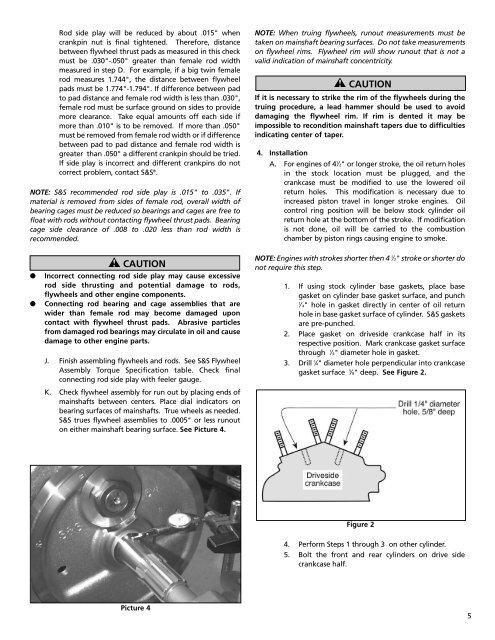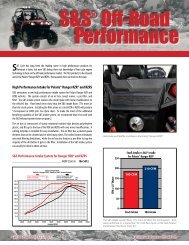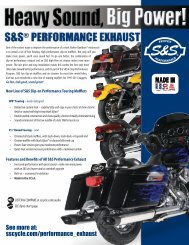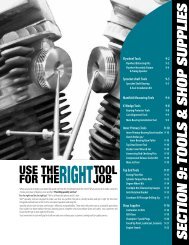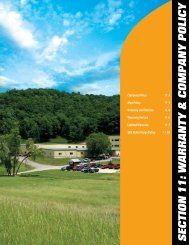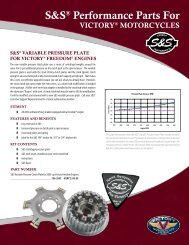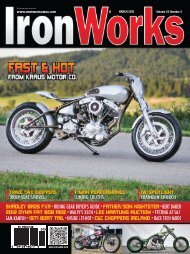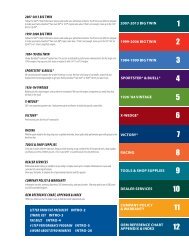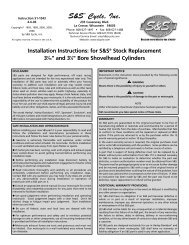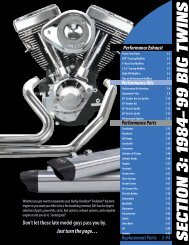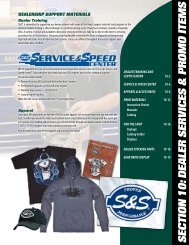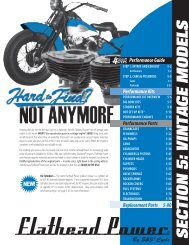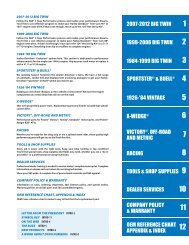Installation Instructions for General Flywheel - S&S Cycle
Installation Instructions for General Flywheel - S&S Cycle
Installation Instructions for General Flywheel - S&S Cycle
Create successful ePaper yourself
Turn your PDF publications into a flip-book with our unique Google optimized e-Paper software.
Rod side play will be reduced by about .015" whencrankpin nut is final tightened. There<strong>for</strong>e, distancebetween flywheel thrust pads as measured in this checkmust be .030"-.050" greater than female rod widthmeasured in step D. For example, if a big twin femalerod measures 1.744", the distance between flywheelpads must be 1.774"-1.794". If difference between padto pad distance and female rod width is less than .030",female rod must be surface ground on sides to providemore clearance. Take equal amounts off each side ifmore than .010" is to be removed. If more than .050"must be removed from female rod width or if differencebetween pad to pad distance and female rod width isgreater than .050" a different crankpin should be tried.If side play is incorrect and different crankpins do notcorrect problem, contact S&S ® .NOTE: S&S recommended rod side play is .015" to .035". Ifmaterial is removed from sides of female rod, overall width ofbearing cages must be reduced so bearings and cages are free tofloat with rods without contacting flywheel thrust pads. Bearingcage side clearance of .008 to .020 less than rod width isrecommended.NOTE: When truing flywheels, runout measurements must betaken on mainshaft bearing surfaces. Do not take measurementson flywheel rims. <strong>Flywheel</strong> rim will show runout that is not avalid indication of mainshaft concentricity.CAUTIONIf it is necessary to strike the rim of the flywheels during thetruing procedure, a lead hammer should be used to avoiddamaging the flywheel rim. If rim is dented it may beimpossible to recondition mainshaft tapers due to difficultiesindicating center of taper.4. <strong>Installation</strong>A. For engines of 4 1 ⁄2" or longer stroke, the oil return holesin the stock location must be plugged, and thecrankcase must be modified to use the lowered oilreturn holes. This modification is necessary due toincreased piston travel in longer stroke engines. Oilcontrol ring position will be below stock cylinder oilreturn hole at the bottom of the stroke. If modificationis not done, oil will be carried to the combustionchamber by piston rings causing engine to smoke.●●CAUTIONIncorrect connecting rod side play may cause excessiverod side thrusting and potential damage to rods,flywheels and other engine components.Connecting rod bearing and cage assemblies that arewider than female rod may become damaged uponcontact with flywheel thrust pads. Abrasive particlesfrom damaged rod bearings may circulate in oil and causedamage to other engine parts.J. Finish assembling flywheels and rods. See S&S <strong>Flywheel</strong>Assembly Torque Specification table. Check finalconnecting rod side play with feeler gauge.K. Check flywheel assembly <strong>for</strong> run out by placing ends ofmainshafts between centers. Place dial indicators onbearing surfaces of mainshafts. True wheels as needed.S&S trues flywheel assemblies to .0005" or less runouton either mainshaft bearing surface. See Picture 4.NOTE: Engines with strokes shorter then 4 1 ⁄2" stroke or shorter donot require this step.1. If using stock cylinder base gaskets, place basegasket on cylinder base gasket surface, and punch1⁄ 4" hole in gasket directly in center of oil returnhole in base gasket surface of cylinder. S&S gasketsare pre-punched.2. Place gasket on driveside crankcase half in itsrespective position. Mark crankcase gasket surfacethrough 1 ⁄4" diameter hole in gasket.3. Drill 1 ⁄4" diameter hole perpendicular into crankcasegasket surface 5 ⁄8" deep. See Figure 2.Figure 24. Per<strong>for</strong>m Steps 1 through 3 on other cylinder.5. Bolt the front and rear cylinders on drive sidecrankcase half.Picture 45


